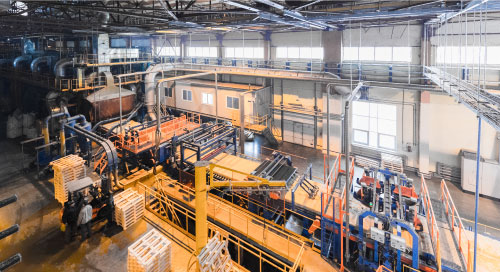Fill form to unlock content
Error - something went wrong!
Stay up to date with the latest IoT and network edge news.
Subscribed.
Software-Centric Automation Transforms Process Industry

Proprietary distributed control systems and hardware that run many industrial plants are nearing obsolescence. The replacement of these systems is complex, expensive, and typically requires downtime. In addition to these challenges, workers with specialized automation knowledge are aging out of the workforce.
Automation and digitalization offer an alternative. Plants can be fitted with software-centric systems that provide flexibility, high availability, and resilience while also supporting sustainability goals. One such solution uses open-standards technology for automation by decoupling control software from hardware. Software-centric automation enables manufacturers to respond to market demands, scale as needed, minimize obsolescence, avoid operational disruption, and optimize energy use.
This solution comes from a partnership between Schneider Electric, Red Hat, and Intel. It leverages Schneider’s EcoStruxture Automation Expert (Soft dPAC), Intel’s Edge Controls for Industrial, and Red Hat Ansible.
“We’re looking to transform from an old proprietary embedded controller architecture to software-centric automation,” says Michael Martinez, Leader of Schneider’s Global Distributed Control Systems.
EcoStruxure Automation Expert uses containerization and orchestration to improve useability, lower cost of ownership, and avoid process disruption. “By leveraging these technologies, we are making the software agnostic to the hardware platform it runs on. We can actually load the control application at a different location or on a different server or even in a different compute capacity. It’s a new way of thinking about automation, and that’s what is going to actually provide us with the resilience and the flexibility that users require,” Martinez says.
The approach ensures continuous operations of processes with zero production interruptions. “Most of our customers operate in what we call a continuous process facility, where they can’t shut down,” Martinez says. Interruptions in power generation could lead to a blackout. In a refinery or chemical production plant, they could cause explosions or spills.
Software Orchestration for Continuous Operation
Because of this need for continuous operation, replacing technology at process manufacturing plants becomes complex, timely, and costly. The service, maintenance, and modernizing of proprietary systems, Martinez says, “often require significant outages and turnarounds.”
Red Hat’s Ansible orchestration capabilities are a key part of the overall solution. The new automation solution handles any repetitive and tedious tasks, such as loading software onto a machine or shifting a workload to a different location. “If we have an issue with one of the devices, we use the orchestrator to redeploy the process control application to another healthy device,” Martinez says. This way, workforces can better focus on more innovative activities.
Software-Centric Automation Shortens Learning Curve
Replacing proprietary systems takes a detailed plan and meticulous execution to prevent any interruptions during production. Control systems from the 1980s employed proprietary programming languages that were difficult to translate and required special knowledge. Many companies still use them today.
“It enables a #workforce to be more versatile as deep proprietary knowledge of an #automation system is not required anymore; we are driving to an outcome-based solution” — Tina Volkringer, @SchneiderElec via @insightdottech
It’s a significant pain point addressed by the software-centric approach, says Tina Volkringer, Schneider’s Vice President of Process Automation. “It enables a workforce to be more versatile as deep proprietary knowledge of an automation system is not required anymore; we are driving to an outcome-based solution. We are aiming to deliver plug-and-produce functionality.”
This plug-and-play approach solves another problem: finding qualified talent to run legacy equipment, which is quickly dwindling as workers retire.
“What we’re talking about is a more open standards-based language that is well known by most automation engineers,” says Andre Babineau, Schneider’s Director of Strategic Initiatives. “This way, they can contribute immediately to the value of their process without having to go through some intermediate translation to some proprietary system, proprietary language, or a set of tools that you have to use to control your process.”
Scalability is another benefit. Replicating processes can be a challenge for operators, requiring additional controllers and infrastructure. But EcoStruxure Automation Expert simplifies the process of replicating a tank, pump, or other processes with minimal effort,” Martinez says. It is driven by a system approach. The application is written for optimizing the yield, and the hardware it runs on is selected only in the last step.
The solution between Schneider, Red Hat, and Intel has the potential to transform process automation, setting the stage for future developments. Leveraging orchestration, open standards, and partnerships enables companies to build an automation solution to minimize interruptions, reduce cost of ownership, and reduce the impact of obsolescence. This solution is a path to develop fully autonomous production facilities. While Martinez doesn’t foresee complete autonomy in the near future, he envisions a future where a software-centric automation system works side by side with humans to drive new levels of efficiency, flexibility, and resilience.
Edited by Georganne Benesch, Associate Editorial Director for insight.tech.